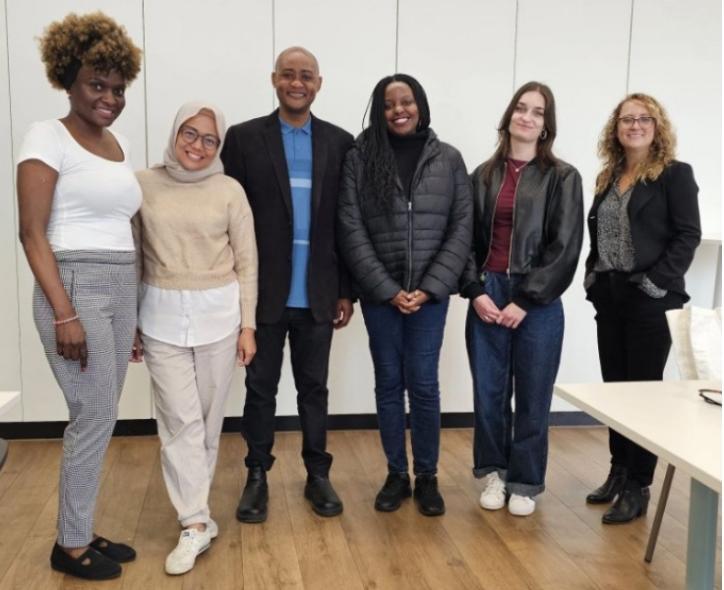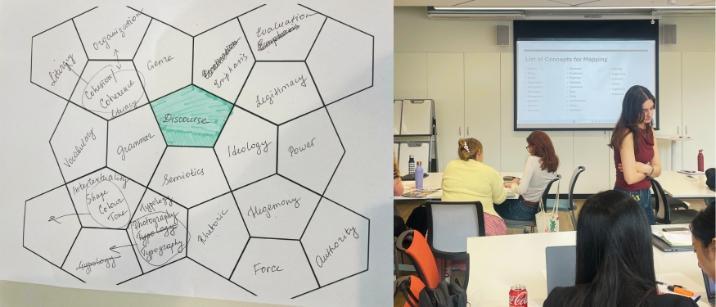Interdisciplinary Multimodal Analysis
Published: 7 August 2025
Inspired by a 2023 SGSAH Summer School session, this workshop blended linguistic discourse analysis with visual methods from design and media theory, empowering postgraduate researchers to critically engage with contemporary visual culture through multimodal analysis.
Anna Talley, Emma Bodig, and Justine Dyikuk — co-organisers of Interdisciplinary Multimodal Analysis (July 2025) — reflect on how a chance meeting at SGSAH’s 2023 Summer School led to a collaborative, cross-disciplinary event exploring multimodal analysis in practice.
Collaborating with students from different universities and fields was at the core of both organising and running our Cohort Development Fund (CDF) workshop on interdisciplinary multimodal analysis.
The idea for the CDF application took shape during a session on teaching, where Emma (Glasgow and Strathclyde) and Anna (University of Edinburgh) first connected and began designing learner-focused activities together. Anna and Emma had the idea to combine our specialisms (Design & Linguistics) to teach students about multimodality, the concept of approaching texts from different modes, such as visual, sound and text. We sketched out an outline in the workshop, and after Anna's suggestion that we could apply for CDF funding to run it, agreed to apply together. As the CDF fund requires collaboration from three Scottish Higher Education Institutions, we needed another PhD student from a Scottish University. After advertising our workshop using various channels, we found Justine from Strathclyde, who also uses multimodality in his work.

Workshop co-organisers — Anna (far right), Emma (second from right), and Justine (centre) — with a group of attendees.
The application process was excellent training in how to write both a workshop outline and grant proposal and made us think about our approach to the session much more deeply. Further, staff from the SGSAH team were very helpful in providing feedback and suggestions. We knew from the start that we wanted to run the workshop at the University of Glasgow’s Advanced Research Centre (ARC), where we had met at the summer school the year before. The ARC is one of the newer buildings on Glasgow’s campus, and thus has accessible and inclusive facilities, a key consideration in our proposal.
In terms of content, we began the session by asking participants to share with each other an example of persuasive media. Emma chose a recent example of a mural at Glastonbury music festival. This depicted politicians, billionaires, and right-wing media personalities being shipped off to Mars. She highlighted the use of multiple modalities in this text, as well as the question of intended audience, and how the text brings the viewer into a shared perspective against the people depicted. Anna used an example from her thesis: two news articles, one from the nineteenth-century and one from the twenty-first, depicting persuasive political communication through the ‘political styling’ of political figures as the “everyman”. The attendees then shared in small groups examples of persuasive media they were asked to bring to the session, which worked both as an ice breaker and a way to get talking about multimodality.
Anna and Emma then co-presented a lecture on concepts in multimodal analysis. Anna’s section focussed on critical visual methodologies, with a focus on the analysis of design artefacts. This focus on design literacy and visual analysis came directly from her thesis research, and presenting her methods was great practice for her upcoming viva! Emma’s presentation was on Critical Discourse Studies (CDS), an approach she uses in her work. CDS is a general principle to text analysis, rather than a specific framework, and is itself interdisciplinary and multifaceted. She emphasised CDS' approach to explore text at various levels of detail, from the in-depth focus of linguistic features to the more abstract power relations and social structures which exist in dialogue with those features. Following this presentation, we asked attendees, in pairs, to map out concepts from our talk. Connecting both familiar and unfamiliar ideas generated debates between pairs, the kind of rich, interdisciplinary discussions we were aiming to encourage.
Attendees then participated in a group multimodal analysis. We split learners into three groups, an ‘audio’ group, a ‘video’ group and a ‘text’ group. One facilitator was assigned to each group, which was assigned a portion of the September 1960 Nixon-Kennedy debate to analyse using a single method of analysis. We then mixed the groups so learners from each of the three analysis groups worked together to create a single, complex multimodal analysis of the debate.

Following lunch, we then listened to a talk from Justine titled ‘Persuasive Media & Media Logic: Multimodal Analysis from Multidisciplinary Perspectives’, which discussed multimodal analysis in relation to Justine’s research on strategic communication by Boko Haram insurgents in juxtaposition with the government’s counterinsurgency efforts. The talk was extremely engaging, and attendees later commented that it was a good way to understand how multimodal analysis is currently being used in a PhD research project.
Although we had a plan for the day, we found ourselves constantly adapting our approach. Everyone who came was so engaged and enthusiastic that we found ourselves having to leave more time for discussion. For example, although we had another activity planned for after Justine’s talk, we decided to end the day with the talk’s Q&A session, which was engaging with many contributions from workshop attendees. Being flexible in this way allowed us to both keep to time and allow the conversation to keep flowing naturally. We also found the lunch break especially helpful to connect with our peers and discuss our research, particularly as the session included a range of students, from those who have just started their PhDs, to those who have already submitted. We also reflected on how learning from fellow students is different from learning from professors, in that the space can feel more open and less intimidating, as it is clear we are all learning from each other, together. This was evident in how deeply engaged the attendees were throughout the day, both in their small group work and feedback to the room.
On the day, attendees commented on how well-organised the workshop had been and that they could see the amount of thought put into each of our activities. They said that they appreciated being introduced to a methodological framework for multimodal analysis that allowed space for the messiness and entanglement of the interdisciplinary research in which many of us are engaged, for instance, one participant said in their feedback,
"Emma, Anna and Justine equipped me with the language I was missing to describe my approach in auditing the institutionalised memorialisation of Adam Smith at the University of Glasgow and have given me the practical confidence to apply MCDA to my research."
Another participant wrote,
"It was great to see through the perspective of researchers in other fields such as design, as we see things kind of differently in a really intriguing way. [The workshop] was well organized and absolutely met my expectations. I think going forward I feel a bit more confident in my own approach to studying multimodality."
We are deeply grateful to SGSAH for funding the Interdisciplinary Multimodal Analysis Workshop. Exploring the principles of multimodal analysis by blending linguistic discourse analysis with visual analysis from design and media theory, we empowered postgraduate researchers to engage with contemporary visual culture critically. We hope our experience inspires others to pursue further funding opportunities from SGSAH to enhance our academic community.
First published: 7 August 2025

